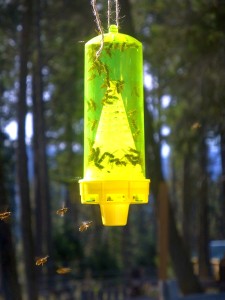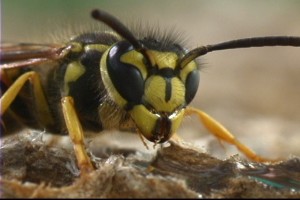Wasp Traps: Superb Marketing

We’re all familiar with those chartreuse-colored wasp traps, right? Especially this time of year as we start thinking about gardening, barbecuing, al fresco dining, outdoor weddings, and Easter egg hunts. There’s nothing can ruin an outside dinner like a bunch of yellow jackets landing all over your food. And they are so pissy! You can’t just wave them away. Everything makes them mad. They come to the table mad. Have you ever had a face full of angry yellow jackets? Try it. It’s fun.
So, if you’re like me, you start hanging wasp traps around the property this time of year. And when you do, you’re doing marketing.
Here’s why: Marketing is, by definition, anything you do to get someone to do something you want them to do, even if they aren’t your species. And wasp traps are the perfect example of that.
Sorry Bees, Wasps Only
In the first place, they are elegantly designed to target only yellow jackets. They use wasp sex pheromones that drive wasps crazy with lust. They don’t hurt bees or other pollinating insects because those guys couldn’t care less; that smell does nothing for them. It always amazes me, when I empty out the desiccated carcasses of my traps in the fall, that the only insects in there are yellow jackets. It’s like there’s a sign on the entrance that says, “RESERVED FOR VESPIDAE FAMILY PICNIC.” What big-data-driven ad agency wouldn’t love to have that kind of market efficiency?
In the second place, because the only chemical the traps use are natural (and concentrated) wasp sex pheromones, they don’t harm the environment. No ecosystem killing pesticides or genetically altered anything. My hat’s off, though, to the brave people who have to extract those sex pheromones from the yellow jackets (they must have very tiny hands).

In the third place, the trap designs take advantage of a peculiarity of the target market (wasps); that they are stupid. Once a wasp climbs into a trap, it just doesn’t have the neural wherewithal to turn around and climb out the way it came. I know a lot of people like this. In a way, the wasp trap follows the same design principle as the typical Las Vegas casino.
And in the fourth, and best, place, this little pheromone broadcaster also lures its target audience with their own vices; lust. I like the moral poetry of that. Prepare one of these things by squeezing in the little phial of sex juice into the cotton in the bottom, and horny insects come from hundreds of feet away, thinking they’re going to get laid. They may even see dozens of the dead carcasses of their compatriots filling the transparent cylinder, but it doesn’t matter; they can’t help themselves. They probably think all those bodies are just having a wasp orgy. “Let me in there!” they cry, in Yellow Jacketese. It’s like a biblical lesson in the wages of sin. An insect Hooters.
Why is this marketing again?
…you’re undoubtedly asking. As I pointed out already to those of you who forget how you climbed into this post, marketing is any technique you employ to get someone to do something you want them to do. In the case of the wasp trap, the thing you want your customer to do is enter and die. A pretty tall order for a marketing campaign. But the inventors of the traps hit upon an enticement that few arthropods (or humans) can resist, the promise of sex.
And sex still sells. Even to invertebrates.
